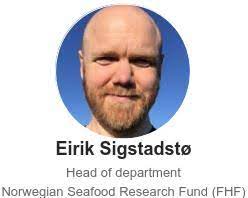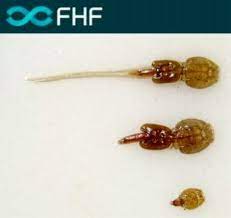|

Image: FHF
Prevention and control of lice - FHF announcement
 (NORWAY, 1/26/2023)
(NORWAY, 1/26/2023)
Prevention and control of salmon lice, and also barnacle lice, is a continuing challenge for the aquaculture industry. Both are naturally occurring parasites in seawater. The announcement will contribute to knowledge about the prevention and control of lice.
Scots lice are parasites of more than 80 different species of wild fish, and can also find their way into semi-closed facilities that take in deep water, while salmon lice mostly stay in the upper water layer and to salmon fish. But more than lice being a direct problem for farmed fish, it is the handling of the fish in connection with the control of lice that is today's challenge, which can affect fish welfare. Good effect and good fish welfare for both salmon and, possibly, cleaning fish when various measures are used are therefore the focus of FHF's call for proposals "Prevention and control of lice 2023".
 "Contributing to new knowledge that can ensure good welfare for cleaning fish is important when the industry uses cleaning fish as lice eaters" says head of department Eirik Sigstadstø at FHF. "Contributing to new knowledge that can ensure good welfare for cleaning fish is important when the industry uses cleaning fish as lice eaters" says head of department Eirik Sigstadstø at FHF.
Sudden infestations of lice are also reported, without it being clear where this is coming from. Are lice that have fallen off in connection with measures in your own facility finding their way back, or are lice that have found their way from facilities far away? There is a lot of research and technology development going on to be able to warn of the presence of lice in the sea in real time, and the FHF wishes with this call to stimulate further work on this.
A notification option can probably also open the way for more proactive use of some preventive measures, only when there appears to be a need. New analysis methods can also make it possible to determine whether a louse  larva comes from a mother louse that has sat on a farmed salmon, on a wild salmon, or a sea trout? If it proves possible, it will be able to contribute as a good tool for validating and further developing the models used to assess the spread of louse larvae.
"Much is known and experienced about the biology of lice and about the prevention and control of lice. Through this call, FHF also wants to contribute to making as much of this knowledge and experience as possible widely available to the entire industry" says Kjell Maroni, Head of Department at FHF.
FHF is awarding up to NOK 60 million to develop and systematize knowledge on the prevention and control of salmon and lice with the best possible fish welfare. It is a large joint call with a total of 6 separate themes and sub-goals.
Information of the company:
|
Address:
|
Tollbugata 32
|
|
City:
|
Oslo
|
|
State/ZIP:
|
(NO-0103)
|
|
Country:
|
Norway
|
|
Phone:
|
+47 23 89 64 08
|
|
Fax:
|
+47 23 89 64 09
|
|
E-Mail:
|
[email protected]
|
More about: 
|
|



